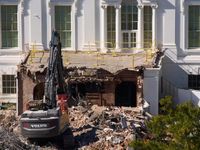On the morning of October 25, 2025, the East Wing of the White House—a landmark space that has welcomed first ladies, dignitaries, and tourists for generations—was reduced to rubble. The demolition, which had been foreshadowed by weeks of speculation and mounting political tension, paves the way for President Donald Trump’s most ambitious renovation yet: a colossal, 90,000-square-foot ballroom intended to host up to 1,000 guests. According to The Hill, this move marks the most significant alteration to the executive mansion in decades—maybe ever—both in scale and in controversy.
The project’s price tag has ballooned. What began as a $200 million proposal has now soared to $300 million, a figure President Trump himself confirmed during an Oval Office address just days before the demolition. “The government is paying absolutely nothing,” Trump told reporters, insisting the project is "paid for 100% by me and some friends of mine." White House press secretary Karoline Leavitt echoed this, stating, "With any construction project, there are changes over time as you assess what the project is going to look like — and we’ll continue to keep you apprised of all of those changes. But just trust the process. This is going to be a magnificent addition to the White House for many years to come."
To avoid using taxpayer money, Trump has turned to a roster of private donors, a list that reads like a who’s who of American business and technology. Commerce Secretary Howard Lutnick and Blackstone CEO Stephen Schwarzman are among the high-profile individual contributors. Corporate giants such as Amazon, Apple, Google, Meta, Microsoft, Coinbase, Ripple, Tether, Lockheed Martin, Palantir, and more have also thrown their hats in the ring. According to an ABC News report, some of these companies have already benefited from lucrative government contracts during Trump’s second term—Microsoft and Google with AI and cloud deals, and Amazon Web Services with up to $1 billion in cloud-credit incentives. The crypto sector, represented by the Winklevoss twins and others, has also seen policy windfalls under Trump’s administration.
But the flow of corporate money into the project has not gone unnoticed by critics. As The Hill points out, Democrats and watchdogs warn that such donations risk becoming a backdoor to presidential favor. “We watched this week the destruction of a symbol of this government,” lamented former RNC chairman Michael Steele on HBO’s "Real Time." “Of our democracy, of our pluralistic society.” Steele, who grew up in Washington, D.C., described the White House as a symbol of his childhood and the nation’s collective memory: “It meant something to me to grow up in a town where everybody in this country came and protested and cried and screamed and laughed.”
Senate Minority Leader Chuck Schumer (D-N.Y.) didn’t mince words, calling the project a "vanity project." Senator Richard Blumenthal (D-Conn.) labeled the demolition "heartbreaking," while Senator Elizabeth Warren (D-Mass.) took to social media to criticize the timing: “Oh you’re trying to say the cost of living is skyrocketing? Donald Trump can’t hear you over the sound of bulldozers demolishing a wing of the White House to build a new grand ballroom.” According to Fox News, Kate Bedingfield, former Biden White House communications director, argued that the ballroom construction is “part of a manner of governing that is tearing at some of the foundations, the institutional foundations in this country. And that’s scary.”
Republicans, on the other hand, have largely praised the project or shrugged off the criticism. “You’ve got a builder who has [an] eye for construction and for excellence. What better person would you want to renovate the White House?” Senator Markwayne Mullin (R-Okla.) told The Associated Press. Even Bill Maher, host of "Real Time," while alarmed by the symbolism, noted, “Presidents do change the buildings. Nixon put in a bowling alley. Obama made the tennis court a basketball court. I can’t get this mad about everything, Mike. I just can’t.”
Still, the ballroom’s sheer size is raising eyebrows. At 90,000 square feet, it will dwarf the main White House residence, which totals just 55,000 square feet. The new venue is designed to eliminate the need for temporary tents on the South Lawn for major events, offering a permanent space for state dinners, ceremonies, and—critics fear—political rallies. According to The New York Times, the ballroom’s capacity of 1,000 guests is a dramatic increase from the East Room’s 200-person limit.
The funding mechanism for the project is complex. Donations are being funneled through the Trust for the National Mall, a nonprofit that supports the National Park Service and White House restoration efforts. Google’s parent company, Alphabet, agreed to contribute $22 million to the Trust as part of a legal settlement following Trump’s ban from YouTube after January 6, 2021. Paolo Tiramani, CEO of a construction firm, donated $10 million in stock, according to his company’s statement. Meredith O’Rourke, the financial director of Trump’s 2024 campaign, is leading the donor effort, while the National Park Service and the White House oversee the design and construction.
Despite the administration’s insistence that the project is above board, transparency concerns linger. The White House has yet to release a full list of donors, and preservation groups have called for a pause in construction to assess the impact on the historic site. According to multiple outlets, the Treasury Department, whose headquarters overlook the demolition site, has instructed employees not to share photos of the ongoing work—a move that has only fueled speculation about the project’s implications.
Historically, presidents have altered the White House to suit their needs. Theodore Roosevelt’s 1902 renovation created the original East Wing, while Franklin Roosevelt and Harry S. Truman made sweeping changes in the 1940s. More recently, presidents have added recreational spaces or updated amenities. Yet, as Bill Maher pointed out, “That part of the building wasn’t always there,” underscoring the tension between tradition and progress.
Ultimately, the ballroom project has become a lightning rod for the nation’s political divisions. For Trump’s supporters, it’s a testament to his vision and legacy as a builder-president. For his critics, it’s a symbol of excess, disregard for tradition, and a broader pattern of controversial governance. Whether the new ballroom will become a celebrated venue or a cautionary tale remains to be seen. But for now, the bulldozers have spoken, and the White House will never look quite the same.






